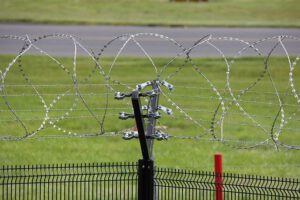An electrical fence is a great way to keep animals, children, and pets safe. It will help keep your property safe. An electrical fence is not only effective but also looks good! The most important part of a fence is the grounding system. The ground rods should be six to eight feet long and placed two to three meters apart from the energizer. They should be connected with galvanized wire and insulated to prevent tripping.

When installing an electric fence, you must take special care in the grounding of the electric system. You should use the insulated cable that runs under gates and is water-tight to do this. It would help if you connected all electrified wires at corners and gates. This will help to increase the voltage throughout the entire fence. It is good to conduct all your wires in one direction and preferably parallel to the ground. Generally, you can find an electric fence energizer on the Internet.
Another important aspect of an electrical fence is the grounding system. Without proper grounding, the full capacity of an energizer can’t be utilized. This is why it’s critical to have the proper spacing between the grounding wires. An electrical fence should have three feet of ground rods for every joule of power output. Once the fence is installed, you will want to use a key switch to turn on and off the power.
The energizer is the power source in an electrical fence. It emits a high-voltage electric jolt every second. The energizer is plugged into an outlet or battery, but some are solar-powered. The fence must be connected at corners and gates to prevent tripping. A key switch will help keep your pet safe. Adding a key switch to your electric fence will make your property safer. It will protect your animals and ensure that you stay safe.
The power source for an electrical fence is an energizer. This device emits a high-voltage electric pulse every second to deter unwanted animals. A wired fence is usually made of steel or aluminum and insulated with an insulator. The energizer is an important component of an electric fence. The energizer will cause an electric shock to the grounding rods during an electrical storm. The voltage will increase as the current is turned on and off.
Using an electrical fence is not a simple task. Creating an electric fence requires a lot of care. It’s important to remember that the wire must be insulated and safe for the animals. This is a very effective way to keep your pet and your home safe. The voltage should be low enough to protect your pets or your house. The energizer should be located at the entrance to your property. The energizer must be located in a safe place where unauthorized people can’t easily reach it.
An electrical fence requires daily checks to keep it safe. The energizer should be placed within a certain distance from the ground rods. If the ground is too close to the ground, the fence will not work properly. Besides the energizer, other parts of an electric fencing system need to be maintained. A properly-maintained fence will ensure your pet’s safety. If the gate isn’t in the proper position, the energizer might fail to work.
A properly installed electric fence has two main components. The energizer is the power source and emits a high-voltage electric jolt every second. The energizer is usually battery-powered or solar-powered. The energizer is a crucial component of any electric fence. In fact, if you have the proper wires, you’ll have less chance of an animal being shocked. You’ll have to make sure that they are all grounded before a wire can be inserted.
When installing an electric fence, make sure that you ground the wires properly. The electric fence will not work properly if the ground isn’t sufficiently grounded. The grounding rods are located below each gate and are essential for the safety of your animals. In addition, the energizer should be placed about eight feet away from the gate. The wiring should be grounded with a metal object such as a tree. A wire that is connected to a tree will not be able to function properly if it is near the tree or ground.